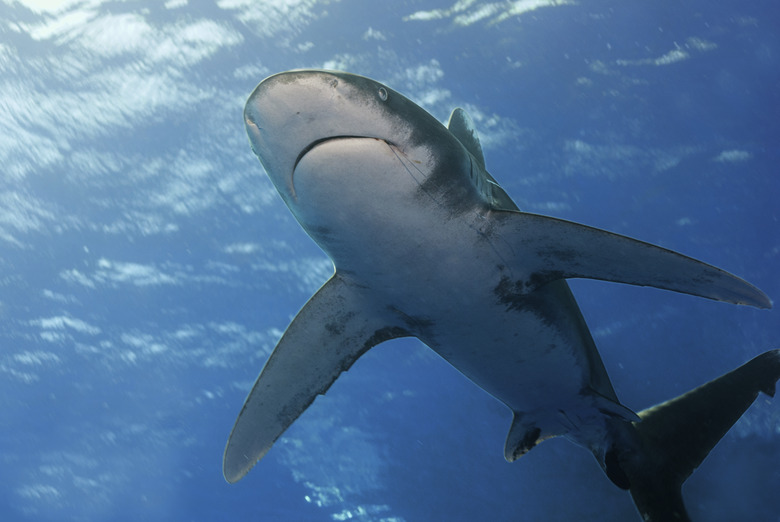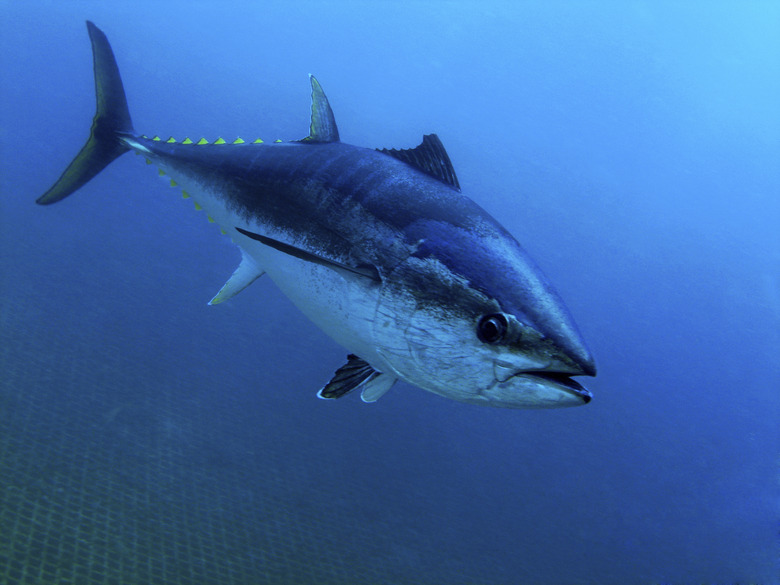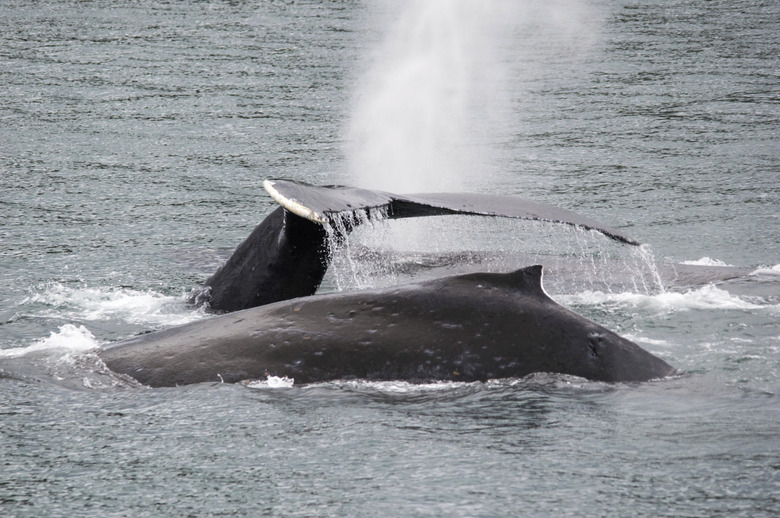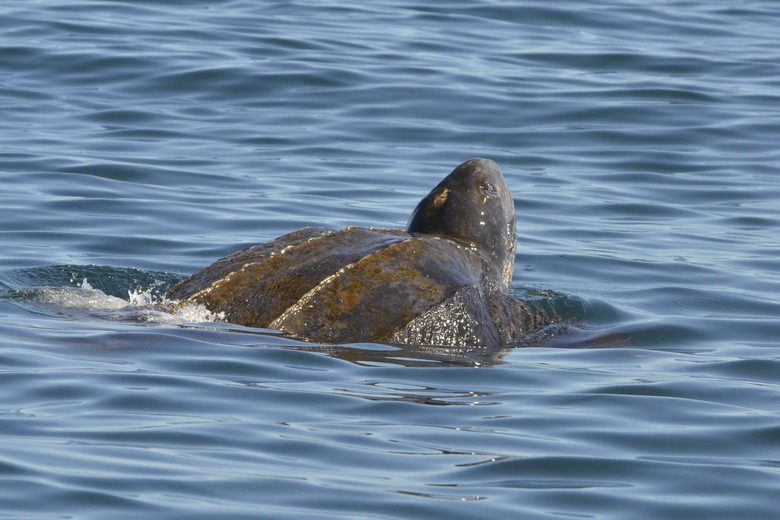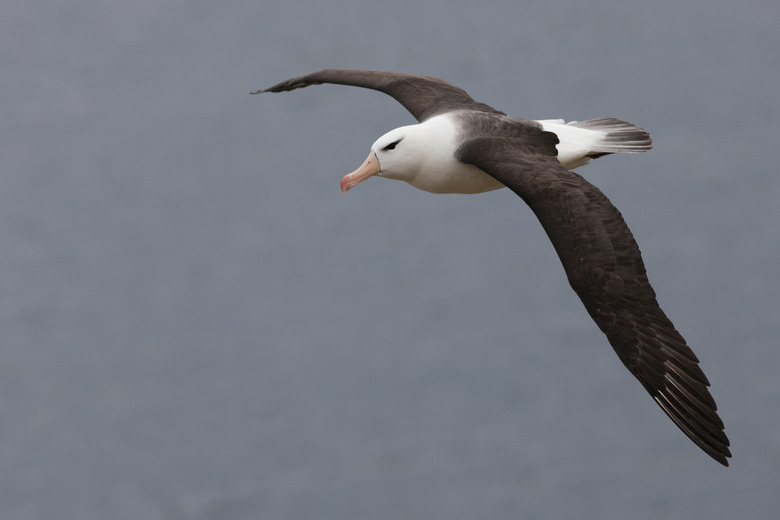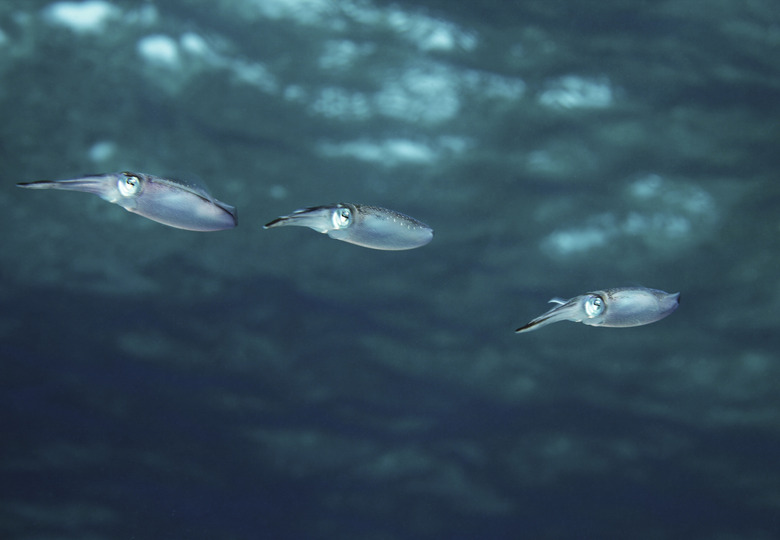Which Animals Live On The Pelagic Zone?
Accounting for some 330 million cubic miles, the pelagic zone – the offshore waters of the ocean – is the world's most extensive habitat. Although vast reaches of it are relatively barren compared to the lively richness of coastal realms, the open ocean plays host to a vast array of wildlife, including many interesting pelagic zone animals.
Ancient Marine Sharks
Ancient Marine Sharks
Among the top pelagic zone predators are large, open-ocean sharks, including various members of the requiem shark family. The oceanic whitetip shark typifies the ecology of these magnificent predators. A stocky, pugnacious species that may reach four meters (13 feet) in length, the oceanic whitetip shark opportunistically feeds on a wide range of prey, from offal to jellyfish to seabirds. Certain mackerel sharks are also notable pelagic zone animal species. Toothy mako sharks are powerful, swift fish capable of reaching speeds of 74 kilometers per hour (46 mph) in pursuit of active prey such as tuna, billfish and dolphins. Deep-sea species include the wild-looking goblin shark, characterized by needle-like teeth and a prominent, horn-like snout.
Bony Fish Species
Bony Fish Species
A wheeling diversity of bony fish track the great currents of the open ocean, from small planktivorous species such as anchovies to high-level predators such as tuna and swordfish. Among them, too, is the most massive of all bony fish, the ocean sunfish. Some of these species undergo remarkable seasonal migrations encompassing huge distances. For example, Atlantic blue marlin – the largest of the billfish – have been documented traveling more than 14,500 kilometers (9,010 miles) between the Atlantic and Indian oceans. In the deep, black bathypelagic zone, anglerfish attract prey with bioluminescent lures. Pelagic freshwater fish include Africa's Nile perch and North America's lake trout.
Marine Mammals
Marine Mammals
Many cetaceans (whales and dolphins) forage and travel in the pelagic zone. Baleen whales conduct long-distance migrations between feeding and breeding waters, some of which include extensive time far out to sea. One example is the epic treks of North Pacific humpback whales between Japan or Hawaii and the North American west coast.
Adding to the species diversity in the pelagic zone are several distinct types of orcas, including little-known "offshore" killer whales that seem to prey heavily on sharks. Amazingly, some marine mammals that frequent the pelagic zone – notably the sperm whale, beaked whales and elephant seals – are capable of diving to great depths well beyond 1,000 meters (620 feet).
Pelagic Zone Reptiles
Pelagic Zone Reptiles
Several species of sea turtles roam the oceanic highways. The farthest ranging species seems to be the leatherback turtle, which is also by far the biggest. These huge jellyfish eaters trek across the Pacific Ocean basin between Indonesian nesting beaches and feeding grounds off the mouth of the Columbia River in the Pacific Northwest, as well as between the Caribbean Sea and Newfoundland. Most sea snakes are fairly coastal in distribution and habit, but one species, the pelagic sea snake or yellow-bellied sea snake, readily swims the open ocean.
Pelagic Zone Seabirds
Pelagic Zone Seabirds
Efficient long-distance flyers, many seabirds roam the pelagic zone thousands of kilometers from land, mainly feeding on small fish and squid. Some spend most of their time on the wing, landing only to nest. The sooty tern and wandering albatross – the latter is one of the largest of the world's flying birds – are among the most famed pelagic zone travelers. Some open-ocean seabirds may associate with underwater hunters such as tuna, as they all target the same food: small fish.
Invertebrate Animal Species
Invertebrate Animal Species
A plethora of squid species help compose the pelagic zone food web, functioning both as active hunters in their own right and as prey for numerous fish, birds and marine mammals. Among the most formidable is the Humboldt squid, which may weigh 50 kilograms (110 lbs.). Numerous jellyfish also passively ride pelagic currents, including the notorious Portuguese man o' war, which also can sail by virtue of a specialized, wind-catching structure called a pneumatophore.
References
- ReefQuest Centre for Shark Research: How Fast Can a Shark Swim?
- Tuna Research and Conservation Center: Billfish Tagging
- Alaska Department of Fish and Game: Humpback Whale
- National Oceanic and Atmospheric Administration: NOAA Fisheries – Leatherback Turtle
- PLoS One; From the Eye of the Albatrosses: A Bird-Borne Camera Shows an Association between Albatrosses and a Killer Whale in the Southern Ocean; Kentaro Q. Sakamoto, et al.
Cite This Article
MLA
Shaw, Ethan. "Which Animals Live On The Pelagic Zone?" sciencing.com, https://www.sciencing.com/animals-live-pelagic-zone-8429464/. 30 September 2021.
APA
Shaw, Ethan. (2021, September 30). Which Animals Live On The Pelagic Zone?. sciencing.com. Retrieved from https://www.sciencing.com/animals-live-pelagic-zone-8429464/
Chicago
Shaw, Ethan. Which Animals Live On The Pelagic Zone? last modified August 30, 2022. https://www.sciencing.com/animals-live-pelagic-zone-8429464/

